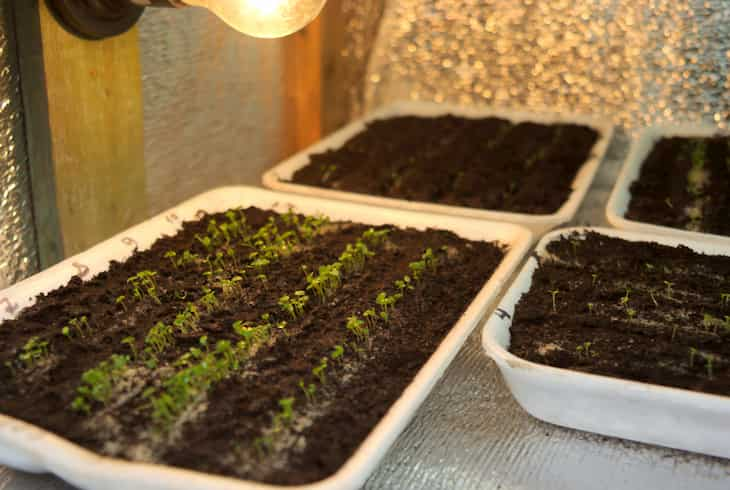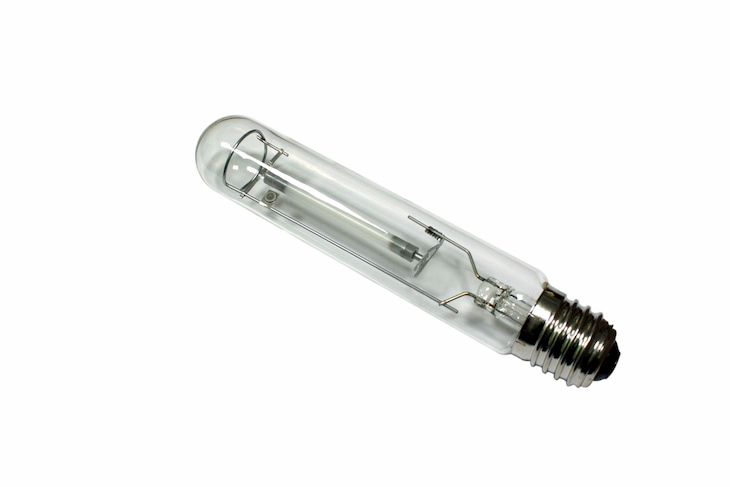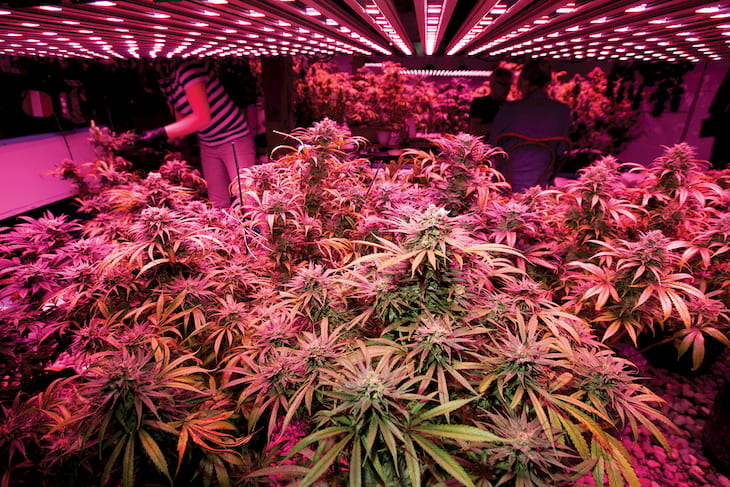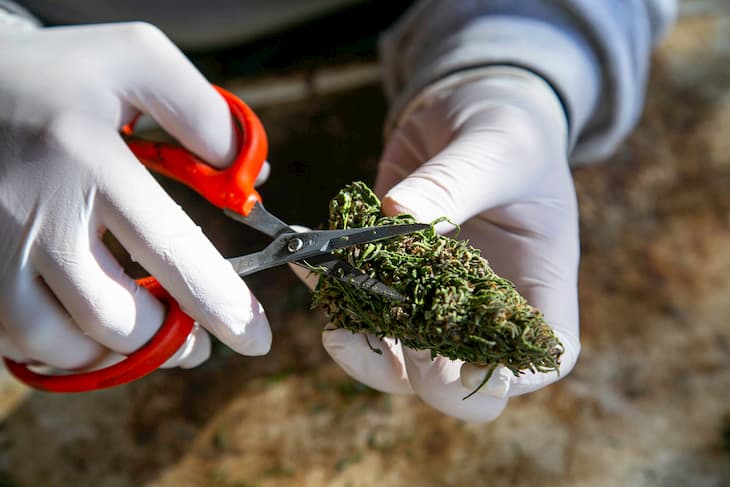
If you’re venturing into marijuana growing for the first time, you might be wondering which cannabis growing supplies you need to use to produce high-quality marijuana. Well, worry no more, as this ultimate cannabis grow guide shows you each item you need to get started with indoor grow – and where to get it.
First, you should decide on the number and size of plants you’d like to grow. The cannabis plant can grow as high as 18 feet (5.5 meters). But for indoor growing, you want your plants to fit in a small tent. For example, you may let your plants grow up to two or three feet (from 0.6 to 1 meter). Here are the important cannabis growing supplies you need to get started.
Cannabis grow tent
Invest in a good grow tent to create a suitable environment for indoor growing, which you can control. The more you can control the environment, the more control and mastery you’ll have over the bud. The best tent not only covers your garden but also hides the smell that emanates from the plants and helps to spread the light inside more efficiently.
Reliable grow tents are made of high-quality and durable material to prevent pests and external contaminants from invading the space. The material should reflect light inside the tent. This increases its power without consuming more energy.

Choosing a good tent
Usually, if you buy a good tent, it can last forever. In most cases, people grow up to four plants. In most states, it’s the number of plants legally allowed to grow (you should check the laws in your country or state before any start). If your target is four plants, your tent is enough to be 48x48x80 inches (120x120x200cm).
Grow tents are available from various online outlets. Different brands are available too. All the same, be careful when shopping to avoid cheap brands. Mostly they are made of low-quality materials and have problems with zippers and frames. They are also weak and challenging to assemble and dismantle, among other issues. Considering that you only buy it once, investing in great marijuana grow tent is the best step you can take.
Grow lights
It’s one of the most important supplies for growing cannabis indoors. The cannabis plant requires five very important conditions to grow:
- Light
- Temperature
- Humidity
- CO2
- Fertilizers (Cannabis nutrients)
The ultimate yield depends on the quality of the environment you create for your plants to grow. With a perfect growing environment, you can expect maximum yield. Before you decide which light to buy, it’s essential to know all available types for indoor grow. Some of them are not used so often anymore, but it’s good to know all.
According to Ed Rosenthal, the author of the Marijuana Grower’s Handbook, “Plants use light for several purposes including the regulation of life processes such as the initiation of flowering. But the most amazing thing that they do with light (which you probably know) is photosynthesis, the process that provides the foundation for most of life on Earth.”
Types of lights
Various terms describe the energy output of different lamps. Understanding the relationship between the lights and other aspects like wattage and luminance output can help you make a meaningful comparison between the products. There are five main types of lighting:
- Incandescent
- Compact Fluorescent Lights (CFL)
- High-Pressure Sodium Vapor (HPS)
- Metal Halides (MH)
- Light Emitting Diodes (LEDs)
Incandescent vs. Fluorescent
Incandescent and fluorescent lights are the most common lighting systems. They have been available in many homes for many years, even though more and more people today use LED lights in their homes. From the early 1960s, growers used the incandescent and fluorescent lights. But as better, more powerful and more efficient options emerged, they shifted their preferences.

Incidentally, fluorescent systems are three or four times more efficient than incandescent lights. A 20W fluorescent light can deliver equal lighting output as a 75W bulb. They also produce better spectrum lights, which is quite important in marijuana growing. The plant requires a different spectrum of light at different stages of growth (vegetative and flowering).

Before the technology existed to make a suitable lamp for the whole plant’s lifecycle, growers used different lamps for all growth stages. Even today, some growers continue to use fluorescent lights in the seedlings stage. Cooler fluorescents can be closer to the canopy than HPS lamps that are hot and produce a lot of heat.
MH versus HPS
Rosenthal adds in his book, “MH lamps are the type of lamp used outdoors to illuminate sports events because they emit white light. They were originally promoted as the light to use during the vegetative stage of plant growth before the plants are forced to flower. But now it is generally recognized that plants grow as well vegetatively under HPS lamps as under MH, so they are not used that much because they emit less total light than HPS lamps produce lower yields.”

High-Pressure Sodium Vapor Lights (HPS) emit an orange or amber-looking luminance. Mostly used as streetlights, they display a heavy concentration of yellow, orange, and red spectrums with only a touch of blue. These lamps improved from the ancient models. Today, companies such as Osram make good quality HPS lamps suitable for vegetative and flowering stages.
HPS lamp outputs
Most growers prefer 250, 400, 600, and 1000 Watts. HPS lamps are a good option for your tent, but not the best because they produce a lot of heat. If you decide to use them, it’s advisable to change the bulbs at least every three or four yields. Remember, good quality lighting for your plants is not cheap. A set of HPS lamps costs between $40 and $299. Pricing does change, so it’s better to inquire before you place an order. The whole set contains the lamp itself, ballast, and wings (reflectors).
Cheaper options are also available. But as mentioned earlier in this guide, cheap can be expensive in the end. Cheap HPS lamps come with magnetic ballasts, which are old tech, consume more energy, and produce more heat. Expensive models use digital electronic ballasts. Theoretically, if you manage to make an ideal growing environment, you can expect one gram per one Watt of yield.
For instance, if you use 1 light of 600W in your tent with 4 plants, you can expect up to 150 grams from one plant. That amounts to a total of 600 grams of yield. However, it’s more easily said than done. Most growers harvest an average of 500-550 grams from 600 Watts, which is a great achievement.
LED lights
LED lights became quite an attractive choice of cannabis growing supplies just recently. Not so long ago, LEDs had an inadequate light spectrum for healthy plant growth. Therefore, growers with a bigger volume of plants indoors used to mix HPS lights with LEDs to save cost on electricity and to manage heat. LEDs produce little or no heat.

LED lights are available in many configurations, including floodlights, panels, bars, circles, and rectangular fixtures. They create little heat, and the fixtures are only three or four inches deep. This makes them a preferred choice where height is an issue, especially in tents.
LED luminance output
LED lights emit light in a narrow portion of the light spectrum. Their light output is concentrated in red and blue, which are the light bands that marijuana plants use most efficiently. Importantly, LEDs can produce PAR (Photosynthetic Active Radiation) more efficiently. PAR is an important aspect of horticultural lighting, which refers to the light wavelengths used by plants for photosynthesis.
HPS lamps deliver more total light per watt of input, but LEDs are twice as efficient in PAR light per watt as HPS lamps. A 200W LED lamp can substitute for a 400W HPS lamp. Similarly, a 300W LED lamp can substitute for a 600W HPS lamp. Besides, LED lamps to use around 30% less electricity than HPS lights. For instance, an 800W LED light produces the same amount of energy needed for plant growth as 1000W HPS light, using 30% less electricity.
All factors considered, you could expect 1000 grams of yield from 800W LED lights. Importantly, LED lights produce no heat while a 1000W HPS light can burn your plant if the garden has no proper ventilation or you don’t cool down the air within the tent. An 800W (~79000 lumens) LED lamp usually takes 120×120 cm space, so it works well with a 48x48x80 inch tent. Overall, you should decide which type of lighting to use. Whether HPS or LED, it’s an important step. For HPS lights, you may need a small air conditioner to regulate the temperature inside the tent.
The best-known brands for grow lights are Vivosun, Gavita, Spider Farm, Mars Hydro. You will get good quality light for your plants using those brands. The link below is more than 800W Spider Farmer lamp that fits 48x48x80 inch tent and is very easy to assemble.
LEDs efficiency measurements
The industry standard for measuring LED light efficiency is micromole per joule (μmol/j). Plants use photons to perform photosynthesis to produce energy for growth, and μmolis represents the concrete number of photons.
J = energy unit in joules
S = time unit in seconds
W = energy unit in watts
W= j/s (energy over time)
If reading the manufacturer’s specification sheet, you find a number like PPF = 1500 μmol/s, which shows how many photons this light can spread per second. While it says nothing about the efficiency, it is worth mentioning that this amount is enough if you don’t use extra CO2 machines.
What about efficiency? More efficient lights will spread more photons per watt (μmol/j). To calculate it, you need to divide μmol/s by the watts of light used to produce the μmol/j.
1500 μmol/s on 800W light: 1500/800= 1.87 μmol/j
Most HID lights reach around 1.7 umol/J efficiencies. These days many new generations of LED lights deliver between 2.6 μmol/j – 3 μmol/j.
Exhaust fan
The next piece, of cannabis growing supplies you need for effective plant growth, is an exhaust fan. While there is not much to talk about here, the exhaust fan sucks out old air from the tent. This action controls heat and humidity. Most fans come with sensors that automatically suck more air out when it’s too hot. You can buy it with or without a temperature controller. It will be cheaper without, but you will have to adjust the fan speed manually every time you see that more fresh air is needed or temperature has risen too high.
Environmental control plays a vital role in the growth of your plants. Once you know your options, you can choose a powerful machine to serve your garden. Usually, a 48x48x80 inch tent requires just one fan with 700 CFM (airflow measurement). On Amazon, you can find a suitable fan designed to offer quiet ventilation for your garden. Besides, it boosts heating and cooling within the tent to ensure that the plants get sufficient airflow at all times.
Air filter
Keep in mind that the sucked air from the tent will contain the smell of weed. In vegetative stages, the smell isn’t so strong, but when the plants reach the flowering stage, the smell becomes quite intense. The intensity depends on the cannabis strain you grow. To manage the smell, you need a filter, which goes inside the tent before the exhaust fan. The air first passes through the filter then through the exhaust fan and, then out of the tent.

More advanced options such as ionizers exist, but the ordinary carbon filter works just fine. Before you buy, ensure that the dimensions of the filter tube and exhaust fan are matching. This is helpful for proper mounting. We found you some options in the links below.
Intake air fan
Unlike the earlier mentioned exhaust fan, which extracts air from the tent, an intake fan draws fresh air into the tent. Most people in small tents use only the exhaust fan and leave some holes or one hole with a tube placed where you want the air to be taken from (for example, near the open window, to let in fresh air). Well, this method works well, and we will leave you with this option. But if you will feel later that it’s not enough for your plants, you can always buy a separate exhaust fan and use it vice versa to drive the air to your tent. Fresh air gives your plants a good dose of Carbon dioxide (CO2), which is one of the five main factors for proper growth. As a rule, you need at least 30-40% more powerful fan to suck out air to make a small vacuum inside the tent.
When you have a bigger tent, you can buy just simple exhaust fan boxes (one for the air to be sucked in and other sucked out) and use advanced controllers (for example, SMSCOM controllers) where you plug both boxes in. Those controllers automatically regulate exhaust fan boxes to make optimal airflow. When the temperature inside the tent rises, it gives more power to the fans and vice versa.
Humidifier and dehumidifier
This tool is necessary to keep the right humidity inside the tent. For small home growers, most of them work just fine. If you have space, you can put the humidifier inside the tent. Better still, you can place it outside the tent and connect it to the special holes in the tent, so it stays outside. In that case, you’ll need to figure out how to connect the blowing humid air to the tent, so it freely spreads inside the tent.
Connecting the humidifier
Based on the type of humidifier you use, you could use plastic tubes or any suitable connection to ensure that everything runs efficiently. A humidifier is more needed in the vegetative stage to keep the air more humid, like in the tropics. In the flowering stage, the level of humidity should go down. In a small tent with only a few plants, you can use air extractors to help keep the humidity low. About 45-50% is sufficient.
However, if that’s not enough, you can use a dehumidifier too. These are available in many models with different moisture absorption. For a small tent, most homemade models work just fine. Overall, humidity is part of air quality, which you must consider for your plants’ effective growth. As Ed writes, “Besides temperature and CO2 content, other things to consider about the air in your garden, include dust content, electrical charge, and humidity.”
Considering the above instruction, you need to invest in a humidifier and dehumidifier. Also, a very helpful tool to have is a humidity controller plug. When you place your humidifier outside, it helps keep the right humidity level automatically inside your tent. We always give you links to quality products that are not cheap, but if you are tight on budget, items like humidifiers could be bought the cheapest ones, and it will work fine for small tents. Even if you have an old one at your home, there is no reason why you could not use it for your plants.
Advice: if possible, always use reverse osmosis water for humidifiers. It will leave no particles on your plants, lights, and reflectors.
Besides, you should have a good thermometer that can measure humidity in the air. It’s helpful to know the right magnitude of humidity. Refrain from using low-cost thermometers, as they won’t give the exact numbers.
Most of the thermometers used by growers have the sensor at the end of its cable. When you place it near a plant, most of them get affected by direct light. To prevent this, you can try one trick. Take a disposable plastic cup, make a hole on top, put the cable this sensor inside and all sides of the cup wrap with foil. You will get something like a small umbrella/shield from the direct light, so the thermometer will show precise temperature inside your tent.
Water filter
A water filter is an essential tool from the list of cannabis growing supplies. Water composition is measured in three main components: alkalinity, pH (Alkaline-Acid level), and dissolved minerals. Marijuana plants need food made from distilled water with no particles (or water with EC (Electrical Conductivity) of 0.4, which is made by adding an additive to distilled water, but more about this in the next guide about growing). You need Reverse Osmosis (RO) to distill water with zero impurities. Also, as we mentioned before, distilled water is suitable for humidifiers because it contains no minerals, such as calcium.

When you make food for the plants, you will need a handy tool to measure water EC (Electrical Conductivity), temperature, and pH. Company Bluelab manufactures the highest quality tools for this job. They are quite expensive, but as it is a highly important part, it’s not a place to search for cheap ones.
This makes your work easy and each time to prepare food for the plants, you can be sure it’s perfectly balanced for their use.
Fertilizers (Nutrients)
This is probably the last part of the list of cannabis grow supplies. With so many food companies available, it’s impossible to consult all of them. All the same, most of them are good. If you have basic knowledge about plant food, you can even buy separate ingredients. The three most important nutrients are nitrogen, potassium, and phosphorus, or NKP. The amount of each of these elements that the plants need will depend on which stage of growth the plants are in.
Secondary nutrients are calcium, magnesium, and sulfur. The most important are calcium and magnesium. Together they are often called cal-mag. Cal-Mag deficiency is one of the most common problems that cannabis growers face.
However, in that case, you need to know exactly how much of each ingredient your plants need every week. If you cannot determine the right quantities, you should buy food from a reliable fertilizer company. Reliable companies have instruction tables to show how much of their products to use at every stage. You’ll also learn how to mix the product with the right amount of water to make it ready for plant intake. Most know brands are Canna, Dutch Pro, Dutch Ferti, General Hydroponics, and many more.
All fertilizers are chemicals made to get the biggest yield from your plants. But they are chemicals… If you decided to grow weed for your own use and don’t care about maximum yield but the quality, our suggestion would be to look for organic food. Many brands have them. Usually, it is made to mix it in the soil before planting, and it lasts until the crop. Dutch Ferti organic solutions don’t even require you to have RO filters or any other water equipment. After mixing the soil, your plants can be watered with tap water. You will taste something special at the end. We will talk more about fertilizers for cannabis in the next guide.

Other cannabis growing supplies
Now that you have nearly all items from the cannabis growing supplies, you’re almost ready to start your journey of marijuana growing. You may still need a few more little accessories:
- Hangers (for lights and filter),
- Soil. It’s advisable to use a light-mix (lightly fertilized organic soil mixed with perlite). Most of the fertilizer brands have instructions for different types of soil.
- Pots (as mentioned below, you will need 2 sizes, 1 liter, and 8-12 liters). Very important for the pots to have proper drainage holes.
- Lights timer plug (to adjust in every stage how many hours your plants will be with the lights on),
- A simple fan that could be mounted on the tent frame, and
- Water heater (aquarium heater works fine). It should be warm enough (around 21-23 degrees Celsius)
- Surge Protector Power Strip
- Extension Chords (to plug in all of your appliances no matter how spread out they are)
- You will need a small portable AC if you use HPS lamps to cool the air inside your tent.
- An air heater is very useful during the winter months when the fresh air comes too cold. But no matter the season, it will help you regulate both the temperature and humidity levels in your grow tent. Especially at night, when the light is off, it is important to keep the temperature inside the grow tent from falling more than 41F (5 degrees Celsius) from the temperature you have during the day.
If you grow your plants from the seeds, most likely, you’ll need two sizes of pots: A one-liter pot and another one between 8 and 12 liters. When the plants are still young, grow them in smaller pots. Later, you can transfer them to bigger pots. When the plant is small, smaller pots enable them to grow faster and develop bigger roots.
To get ready for cannabis growing will cost you around $3000 if you buy all the high-quality cannabis growing supplies that we talked about here. Of course, many people manage to fit in a $400 – $700 budget, but as you have a deal with electric equipment, you better spend more at the beginning and enjoy the process of growing without troubles and get maximum yield. For a comprehensive manual on how to grow high-quality marijuana, keep it here. Check out our next guide about the cannabis seeds germination stage.
Frequently Asked Questions (FAQs)
What are the optimal cannabis growing conditions?
The ultimate yield depends on the quality of the environment you create for your plants to grow. You need to control light, temperature, humidity, and fresh air.
Seedling stage: humidity not lower than 75%; temperature 77°F (25°C). Nighttime is the same.
Vegetative stage: humidity 65-75%; temperature 77-80°F (25-27°C). Nighttime up to 2-3°C lower.
Flowering stage: humidity not higher than 55%; temperature 77-80°F (25-27°C). Nighttime is up to 2-3° lower, and during the last week of flowering increasing the difference gradually up to 7-10°C.
How many square feet does a 600 Watt light cover?
A 600 Watt light can approximately cover 4×4 feet (120x120cm) and a 1000 Watt light will cover approximately 5×5 feet (160x160cm) of the growing area. No doubt that you can spread them out to the broader area, but keep in mind that the side plants will not be as beautiful as closer ones to the middle as the light density becomes very weak in the corners.
How many plants can you grow under a 600 Watt light?
It depends on the space you have and how big plants you are planning to grow. Therefore, everyone has their way of what works best for them. In most cases, the optimal quantity is from 4 to 6 plants under 600 Watt light.
How much weed can one 600 Watt light produce?
In theory, with ideal environmental conditions, you could expect 1 gram from 1 watt. So, for example, If you are using a 600 Watt HPS light, you can expect a maximum yield of 600 grams. But it’s easier said than done. Most advanced growers manage to get from 500 to 580 grams, and it is considered a very upstanding achievement.
LED or HPS lights are better for growing cannabis?
There is no short answer to it. LEDs became more advanced technically just recently. HPS lights are used by growers for many years before, and many still do, because they are used to it. If you are a new grower, go with LED lights. They produce red and blue light bands and PAR (Photosynthetic Active Radiation) more efficiently than any other lamps. Although HPS lights deliver more total light per watt of input, LEDs are twice as efficient in PAR light per watt as HPS lights. Moreover, LEDs emit almost no heat. All factors considered, you could expect 1000 grams of yield from 800W LED light. Therefore, LEDs are becoming a more attractive choice for growing cannabis. Many growers mixing LEDs with HPS in the same grow room. The main reasons are to help fight low air temperatures and high humidity levels.
How many plants can you grow under 800 Watt LED light?
The optimal quantity is around 9 plants. It mainly depends on how big you want your plants to grow. If you want to save time in the vegetative stage and switch to flowering sooner, then you should think about a bigger number. Some growers even put 16-25 plants under the 800 Watt LEDs and keep them only for a couple of weeks in the vegetative stage.


